Disclosure: My dog blog is supported by dog parents just like you. I only recommend products that I would use on my dogs. All opinions expressed here are my own. I sometimes earn a small affiliate commission, at no extra cost to you, when you click through the affiliate link and purchase something. You can read more about my affiliate policy here.

The winter season has been in full swing for a couple of months here in Colorado. However, when it comes to dog care during Winter, it doesn’t matter where you live. For instance, if the temperature plummets below freezing, you should take precautions to protect your dog.
In general, cold temperatures aren’t a problem for most dogs until they fall below 45 degrees Fahrenheit. Thus, at this point some cold-averse dogs might begin to feel uncomfortable.
However, you should start providing dog care during Winter when temperatures fall below 32 degrees Fahrenheit. Especially if your dog is a small breed, has a thin coat, very young, old, or sick.
Most importantly, you should provide dog care during Winter when temperatures drop under 20 degrees Fahrenheit. Consequently, all dogs are at risk of potentially developing cold-associated health problems, such as hypothermia and frostbite.
Provide Dog Care During Winter When It’s Too Cold
You can prevent either frostbite or hypothermia by being familiar with the signs. Furthermore, knowing when it is time to bring your dog indoors is providing dog care during Winter.
However, if you suspect either condition, immediately take your dog to a warm place and contact your vet.
Frostbite
So, frostbite begins when a dog’s body gets cold, of course. Therefore, the body automatically pulls blood from the extremities to the center of the body to stay warm. A dog’s tail, ears, and paws gets cold enough that ice crystals form in the tissue causing damage.
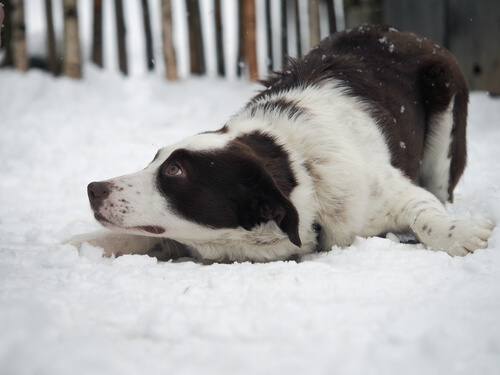
Above all, the most important awareness about frostbite is that it’s not immediately obvious. However, there are some signs you can watch for.
Those include:
- red, pale, or gray skin
- the skin may also turn hard and cold
- swelling and blisters
In addition, severely frostbitten skin will eventually turn black and slough off.
Hypothermia
Do you know that severe hypothermia is life threatening to your dog? It is.
Hypothermia occurs when a dog spends too much time in the cold, or gets wet in cold temperatures. Furthermore, this occurs when dogs with poor health or circulation are exposed to cold weather.
In mild cases, a dog will shiver, as their ears and feet become cold to the human touch. In addition, as hypothermia progresses, a dog may show signs of depression, lethargy, and weakness.
Moreover, as the condition worsens, a dog’s muscles will stiffen. Subsequently, their heart and breathing rates slow down and they will not respond to stimuli.
If It’s too Cold for You, It’s too Cold for Your Dog
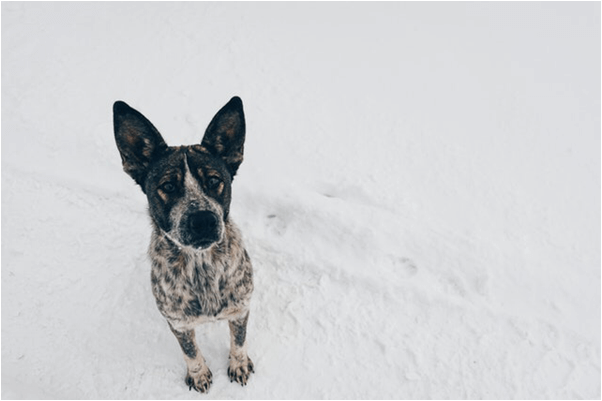
Yes! Dogs do have fur! And, some fur is thicker than others! However, it’s a total myth that because of fur, they are more resistant to cold than people are.
Furthermore, even the longest, thickest-haired dogs are at risk in extremely cold weather conditions. That is with the exception of heavy coated northern breeds that thrive in low temperatures.
Therefore, as dog parents, it is our responsibility to know our dog’s breed tolerance to cold weather.
10 Tips for Dog Care During Winter
1 – Be Prepared
Firstly, make sure you have a pet emergency plan in place. Furthermore, this should be done before the weatherperson predicts extreme cold weather with snow and freezing rain.
You might be snowed in for a while. So, make sure your dog will have plenty of food, water, and prescription medication to last. In addition, you will need to know who you’ll call and how you’ll get there in an emergency.
You should also plan where your dog will potty when blizzard conditions occur. And, it’s a good idea to know how you will dispose of it.
2 – Keep Your Outdoor Dog Inside
Most importantly, if you have an outdoor dog, please bring them inside when temperatures plummet below freezing. Furthermore, it is just cruel and inhumane to leave them outside, especially during the night.
Now, I realize there are some instances that a dog owner feels they can’t bring their dog indoors. But, please do whatever you can to get them inside if this is you. And, if you are a neighbor to an outdoor dog in freezing weather, please offer to help. Dogs deserve to be indoors where it is warm.
3 – In the Case an Outdoor Dog Absolutely Can’t Come Inside
Above all, make sure to provide your dog with unlimited access to fresh water. And, change it often to make sure it doesn’t freeze. You can also look into using a pet-safe heated water bowl.
Furthermore, provide your dog with a warm solid shelter that will hold up against the wind.
“The floor of the shelter should be off of the ground (to minimize heat loss into the ground) and the bedding should be thick, dry and changed regularly to provide a warm, dry environment. The door to the shelter should be positioned away from prevailing winds. Space heaters and heat lamps should be avoided because of the risk of burns or fire. Heated pet mats should also be used with caution because they are still capable of causing burns.”
– The American Veterinary Medical Association (AVMA)
In addition, outdoor shelters should be only slightly larger than a curled-up dog. As a result, a dog’s own body heat will fill up the space to keep him or her warm.
Plus, another option is to keep your dog in the garage if you have one. Consequently, this will help keep the wind off your dog’s back. However, a garage gets extremely cold, so your dog needs a cubbyhole to cuddle inside. For example, something as simple as a cardboard box can help as long as it stays dry.
4- Limit Your Indoor Dog’s Outdoor Time
Your indoor dog may absolutely love outdoor time. However, in extreme conditions, it is best that your dog not stay out for long periods of time.
Nevertheless, you can still take your dog out for exercise by going on more frequent, shorter walks.
5 – Provide Cozy Bedding
Similarly to an outdoor dog, an indoor dog also needs a snug environment for resting and sleeping. For instance, you can ensure your dog stays warm with blankets. Also, place their bed in a warm area away from drafts.
In addition, when possible, keep bedding off cold tiles or concrete. In fact, there are raised beds to help with this. Plus, there are heated pet pads that can help keep the stiffness out of senior dog’s aging joints.
6 – Consider Dog Clothing
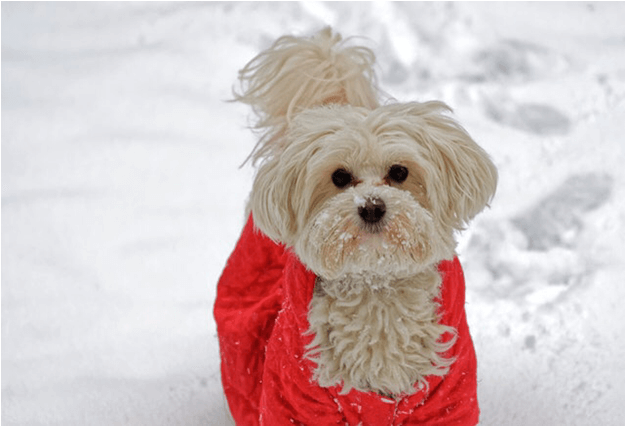
Consequently, outdoor and indoor dogs can benefit from the warmth of a sweater or pajamas. Plus dog booties are an option for paws when going outdoors for exercise, or to potty.
However, most dogs hate the way booties feel on their paws. So, you might have your dog spend some time in them before a severe winter storm.
7 – Paw Care is a Must
Speaking of paws, even if your dog wears the booties, winter weather still causes cracked and dry pads. There are numerous topical salves or balms to choose from online. However, you can also learn how to make your own paw balm here.
In addition, be sure to wash your dog’s paws with warm water after exercising. Especially, if he or she doesn’t wear booties. The salt used on roads and sidewalks to keep us humans safe can burn your dog’s paw pads. Plus, it can be toxic to your dog if licked off.
Another precaution to take is to keep your dog’s hair in between their paw pads trimmed. Therefore, ice balls can’t form when outdoors in snow or freezing rain.
8 – Moisturize Skin, Too
Your dog’s paws aren’t the only thing to suffer in the winter, his or her skin does too. Dry and cold weather can cause dry, flaky skin. However, you can help prevent this by adding a skin and coat supplement to your dog’s food.
In addition, coconut oil is a good natural moisturizer to keep a dog’s skin and coat healthy. You can mix a little in with their food daily. Find out more about coconut oil’s other great benefits for your dog.
9 – Remove Snow From Fences and Rooftops
Not only should snow be removed from a dog’s paw pads, it also should be removed from around fences. Snow piled near fences offers your dog escape routes that even well-trained dogs can’t resist.
Furthermore, pile shoveled snow in your yard away from fences to prevent your dog from climbing over.
Snow and ice often accumulates on rooftops as well. Therefore, if the sun is out or temperatures rise, the accumulation can slide off and injure your dog. So, if it can’t be cleared, keep your dog away from the overhang to prevent injury.
10 – Absolutely Never Leave Your Dog in a Car
So, it is never okay to leave a dog in a car. Period! Just like a car acts as an oven in the summer, it acts like a refrigerator or freezer in the winter. Therefore, leave your dog at home where it is nice and warm while you run errands.

In Conclusion
Our fur babies rely on us to protect them by providing dog care during Winter. So, mainly just use common sense when making decisions for them.
Think about all of the decisions you make to protect yourself. Likewise, most of the time, those same things will apply to protect your dog.
How do you provide dog care during Winter? We would love to read about it in the comments below.
You might like to read these posts from our Dog Health and Wellness section:
- Dog Paw Balm – Great for Dry, Cracked Paws
- Summer Tips for Dog Paw Protection
- The Essentials to Know in Dog First Aid
You can save this post by pinning one of the following images to your Pinterest account.
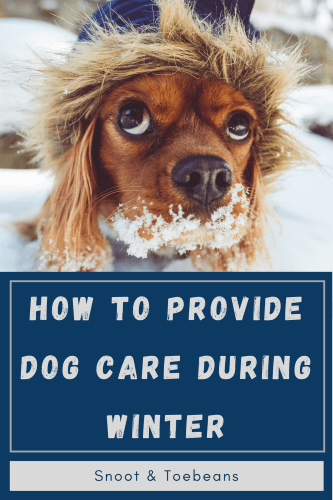
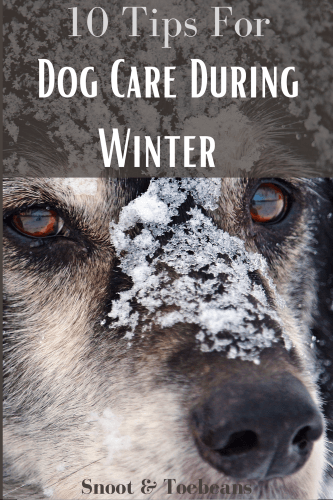
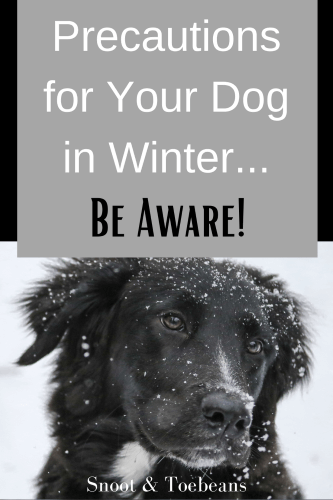
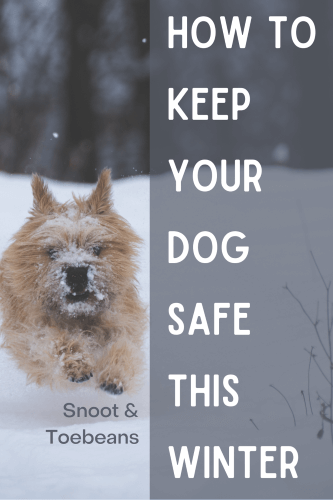

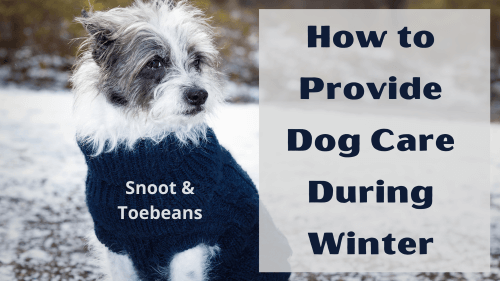
Pingback: Walking Your Dog - Why It’s So Important! | Snoot and Toebeans
Pingback: Have a Dog with Dry, Cracked Paws? – Try Making a DIY Balm – Snoot and Toebeans